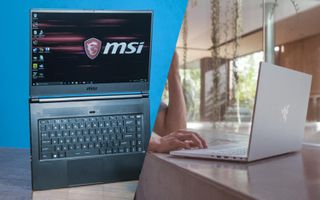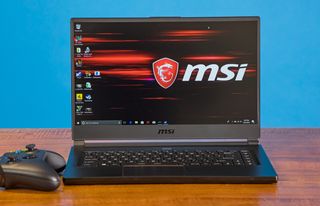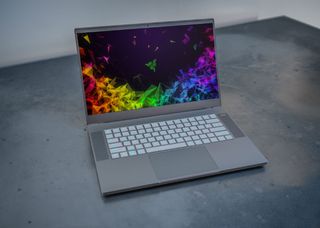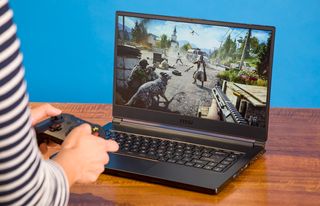Razer Blade 15 vs. MSI GS65 Stealth Thin: Which Gaming Laptop Should You Buy?
With so many gaming laptops on the market, it can be hard to choose, especially when there's a serious price drop.

Such is the dilemma of forum member famillybaror, who is trying to decide between two heavy-hitting lightweights: the MSI GS65 Stealth Thin and the Razer Blade 15. Famillybaror just learned that Razer introduced a new base model of the Blade 15 and writes:
"Now, I am looking at the base models for both, with a GTX 1060. I am leaning towards the MSI laptop because I had some bad experiences with Razer when the finish on my mouse sorta disintegrated (they wouldn't even replace it when it was in warranty). I also know that the performance is similar but I am looking for good battery life, good looks and usability outside of gaming. So if you have one or both, I would Iike to get your feedback. Thanks!"
Unfortunately, Razer has yet to send us a review unit of the new Blade 15 (stay tuned), but I can still give our reader a little bit of insight into both systems.
Design
After years of chunky red-and-black behemoths, the Stealth Thin is like rainfall in the desert— unexpected, yet appreciated. The aluminum chassis is still painted black, but it is elegantly augmented by touches of gold accents. And at 14.1 x 9.8 x 0.7 inches, the 4.1-pound beauty is incredibly light and thin. And despite that svelteness, MSI still managed to fit in several USB 3.1 Type-A ports, a Thunderbolt 3 port, a Mini DisplayPort, HDMI, a secure lock slot, a microphone jack and a S/PDIF jack.

The Blade 15 has also undergone a bit of a makeover. It's still made of CNC aluminum, but Razer ditched the pair of lines across the lid as well as the rounded corners for a more retro, boxy look. And while the Blade's default color is a lovely obsidian, Razer has also started offering the Blade in a striking, limited-edition Mercury White.

In terms of dimensions, the 4.6-pound, 14 x 9.3 x 0.7-inch notebook isn't much thicker or heavier than the Stealth Thin. For ports, you get three USB 3.1 ports, a Thunderbolt 3, HDMI, a Mini DisplayPort, a Gigabit Ethernet, a Kensington lock slot and a headphone jack.
Stay in the know with Laptop Mag
Get our in-depth reviews, helpful tips, great deals, and the biggest news stories delivered to your inbox.
Display
The Stealth Thin's 15.6-inch, 1920 x 1080 display with a 144-Hertz refresh rate is an absolute joy to behold. At 293 nits, the panel has above-average brightness, and with its ability to reproduce 150 percent of the sRGB color gamut, it's exceptionally vibrant.
MORE: The Best Gaming Laptops
I'm hoping the base model Blade's display is a bit better than the top-tier model we reviewed. The screen could reproduce only 112 percent of the sRGB color gamut and had an average brightness of 260 nits. And unlike the Stealth Thin, the entry-level Blade's panel will only have a 60Hz refresh rate, which means that graphics might not render as smoothly as they would on the Stealth Thin.
Gaming, Graphics, VR
With the launch of the base model Razer Blade, it's pretty evenly matched with the Stealth Thin, as they both have Nvidia GeForce GTX 1060 Max-Q GPUs with 6GB of VRAM. Although we haven't reviewed the entry-level iteration of either system, we have looked at the next step up, which is a GTX 1070 Max-Q graphics card.

Barring a few outliers, the laptops delivered similar results. For example, on the Hitman benchmark (1080p on Ultra), the Blade scored 82 frames per second, while the Stealth Thin hit 79 fps. On Rise of the Tomb Raider (1080p, Very High), the Stealth reached 44 fps, but the Blade reached 77 fps. And when we ran the Grand Theft Auto V test, the Blade achieved 66 fps, while the Stealth Thin produced 61 fps.
When we tested for virtual-reality capability, the Blade notched a 10 with the Stealth Thin right behind at 9.5.
Overall Performance
Both entry-level versions of the Razer Blade and the Stealth Thin come equipped with 2.2-GHz Intel Core i7-8750H processors with 16GB of RAM. When we ran Geekbench 4 to test overall performance, the Blade reached 19,011 and the Stealth Thin, 17,184.

During our productivity test, where the laptops are made to pair up 65,000 names and addresses, the Blade completed the task in 40 seconds, while the Stealth Thin finished in 0:54. And on the Handbrake test, the Blade took 11 minutes and 46 seconds to transcode a 4K video to 1080p. The Stealth Thin completed the task in 12:01.
Pricing and Specs
When it ships, the $1,599 base model Blade will have a 2.2-GHz Intel Core i7-8750H processor with 16GB of RAM, a 128GB SSD with a 1TB hard drive, an Nvidia GeForce GTX 1060 Max-Q GPU with 6GB of VRAM and a 1920 x 1080 display with a 60Hz refresh rate. Compare that with the $1,785 Stealth Thin, which has a similar configuration with the exception of the storage, which consists of a single 256GB NVMe PCIe SSD, and a 1080p screen with a 144Hz refresh rate.
Battery Life
Typically, gaming laptops as slim as the Blade and the Stealth Thin aren't known for their battery life, but both laptops managed to defy expectations by lasting over 5 hours.
MORE: Laptops with the Longest Battery Life
The Blade ran 5 hours and 54 minutes on our battery test (continuous web surfing over Wi-Fi at 150 nits). The Stealth Thin wasn't too far behind at 5:40.
Bottom Line
The Razer Blade 15 and MSI GS65 Stealth Thin are both great gaming laptops. They're both extremely stylish and portable and have plenty of power crammed under their thin frames. When it comes to design and display, the Stealth Thin is hands-down the laptop of choice. But when it comes to performance and battery life, the Blade is the better option.
What clinches it for the Blade is the price. You can get a fairly powerful system for $1,599 compared with the $1,785 Stealth Thin. Still, you’ll be pleased with either of these portable gaming laptops.
Credit: Laptop Mag

Sherri L. Smith has been cranking out product reviews for Laptopmag.com since 2011. In that time, she's reviewed more than her share of laptops, tablets, smartphones and everything in between. The resident gamer and audio junkie, Sherri was previously a managing editor for Black Web 2.0 and contributed to BET.Com and Popgadget.
